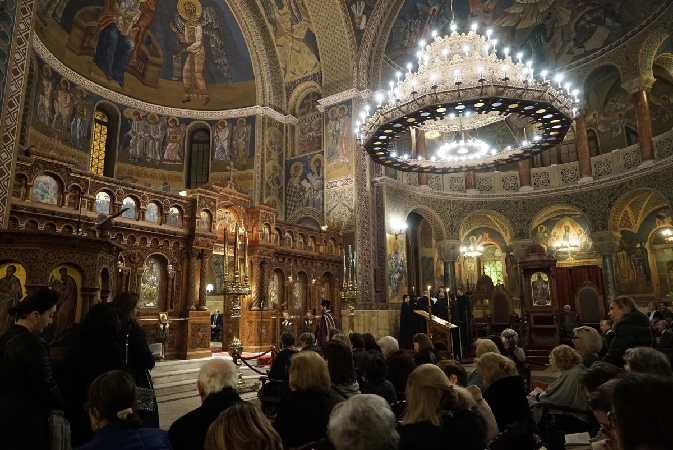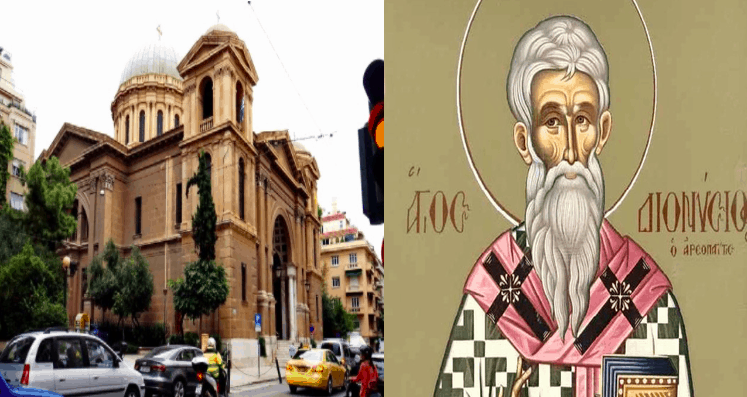On October 3rd, the Greek Orthodox Church celebrates the Feast Day of Agios Dionysios Areopagitis, the first Bishop of the Greek capital and Patron Saint of Athens.

The impressive church located on Skoufas Street at Kolonaki Square is dedicated to the Patron Saint of Athens.
Agios Dionysios lived originally in the city of Athens. He was raised there and received a classical Greek education. He then went to Egypt, where he studied astronomy at the city of Heliopolis. It was in Heliopolis, along with his friend Apollophonos where he witnessed the solar eclipse that occurred at the moment of the death of the Lord Jesus Christ by Crucifixion. “Either the Creator of all the world now suffers, or this visible world is coming to an end,” Dionysius said. Upon his return to Athens from Egypt, he was chosen to be a member of the Areopagus Council (Athenian high court).

When the holy Apostle Paul preached at the place on the Hill of Ares (Acts 17:16-34), Dionysius accepted his salvific proclamation and became a Christian. For three years Agios Dionysios remained a companion of the holy Apostle Paul in preaching the Word of God. Later on, the Apostle Paul selected him as bishop of the city of Athens. And in the year 57 Saint Dionysios was present at the repose of the Most Holy Theotokos.
During the lifetime of the Mother of God, Saint Dionysios had journeyed from Athens to Jerusalem to meet Her. He wrote to his teacher the Apostle Paul: “I witness by God, that besides the very God Himself, there is nothing else filled with such divine power and grace. No one can fully comprehend what I saw. I confess before God: when I was with John, who shone among the Apostles like the sun in the sky when I was brought before the countenance of the Most Holy Virgin, I experienced an inexpressible sensation. Before me gleamed a sort of divine radiance which transfixed my spirit. I perceived the fragrance of indescribable aromas and was filled with such delight that my very body became faint, and my spirit could hardly endure these signs and marks of eternal majesty and heavenly power. The grace from her overwhelmed my heart and shook my very spirit. If I did not have in mind your instruction, I should have mistaken Her for the very God. It is impossible to stand before greater blessedness than this which I beheld.”
After the death of the Apostle Paul, Agios Dionysios wanted to continue with his work and therefore went off preaching in the West, accompanied by the Presbyter Rusticus and Deacon Eleutherius. They converted many to Christ in Rome, and then in Germany, and then in Spain. In Gaul, during a persecution against Christians by the pagan authorities, all three confessors were arrested and thrown into prison. By night Saint Dionysios celebrated the Divine Liturgy with angels of the Lord. In the morning the martyrs were beheaded. According to an old tradition, Saint Dionysios took up his head, proceeded with it to the church and fell down dead there. A pious woman named Catulla buried the relics of the Saint.
Prior to the present-day church of Agios Dionysios in Kolonaki, there was another smaller one, which was constructed around 1880 and was demolished in 1900 in order to build another, larger one. Construction works started in 1925 and were completed in 1931 when the inauguration was carried out by the Archbishop Chrysostomos.

The beautiful charge features a large dome, following the neo-baroque style, and is known for its neo-classical elements in its exterior. It was designed by architect and Byzantologist Anastasios Orlandos, who was also responsible for the supervision of the construction works, which were completed with the contribution of the architect Dimitrios Filippakis.
Some of the most important artists of that time worked on pieces for the church, including the painter Spiros Vasileiou, who painted the icons, Sotirios Varvoglis and Stefanos Xenopoulos, responsible for the mosaics, and Theofanis Nomikos, one of the best wood-carvers, who made the woodworks. The architect Georgios Nomikos, brother of Theofanis was responsible for the general supervision of the interior and exterior decoration. They also made the impressive wooden chandelier of the church. Many of the religious artifacts in the church are donations from prominent Athenians.
The church celebrates today, October 3rd, with celebrations being held throughout Athens.
Xronia Polla!


